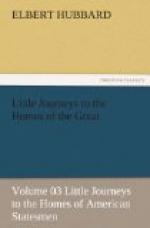And so the object of this sketch will be, not to show the superhuman Washington, the Washington set apart, but to give a glimpse of the man Washington who aspired, feared, hoped, loved and bravely died.
* * * * *
The first biographer of George Washington was the Reverend Mason L. Weems. If you have a copy of Weems’ “Life of Washington,” you had better wrap it in chamois and place it away for your heirs, for some time it will command a price. Fifty editions of Weems’ book were printed, and in its day no other volume approached it in point of popularity. In American literature, Weems stood first. To Weems are we indebted for the hatchet tale, the story of the colt that was broken and killed in the process, and all those other fine romances of Washington’s youth. Weems’ literary style reveals the very acme of that vicious quality of untruth to be found in the old-time Sunday-school books. Weems mustered all the “Little Willie” stories he could find, and attached to them Washington’s name, claiming to write for “the Betterment of the Young,” as if in dealing with the young we should carefully conceal the truth. Possibly Washington could not tell a lie, but Weems was not thus handicapped.
Under a mass of silly moralizing, he nearly buried the real Washington, giving us instead a priggish, punk youth, and a Madame Tussaud, full-dress general, with a wax-works manner and a wooden dignity.
Happily, we have now come to a time when such authors as Mason L. Weems and John S.C. Abbott are no longer accepted as final authorities. We do not discard them, but, like Samuel Pepys, they are retained that they may contribute to the gaiety of nations.
Various violent efforts have been made in days agone to show that Washington was of “a noble line”—as if the natural nobility of the man needed a reason—forgetful that we are all sons of God, and it doth not yet appear what we shall be. But Burke’s “Peerage” lends no light, and the careful, unprejudiced, patient search of recent years finds only the blood of the common people.
Washington himself said that in his opinion the history of his ancestors “was of small moment and a subject to which, I confess, I have paid little attention.”
He had a bookplate and he had also a coat of arms on his carriage-door. The Reverend Mr. Weems has described Washington’s bookplate thus: “Argent, two bar gules in chief, three mullets of the second. Crest, a raven with wings, indorsed proper, issuing out of a ducal coronet, or.”
* * * * *
Mary Ball was the second wife of Augustine Washington. In his will the good man describes this marriage, evidently with a wink, as “my second Venture.” And it is sad to remember that he did not live to know that his “Venture” made America his debtor. The success of the union seems pretty good argument in favor of widowers marrying. There were four children in the family, the oldest nearly full grown, when Mary Ball came to take charge of the household. She was twenty-seven, her husband ten years older. They were married March Sixth, Seventeen Hundred Thirty-one, and on February Twenty-second of the following year was born a man child and they named him George.




